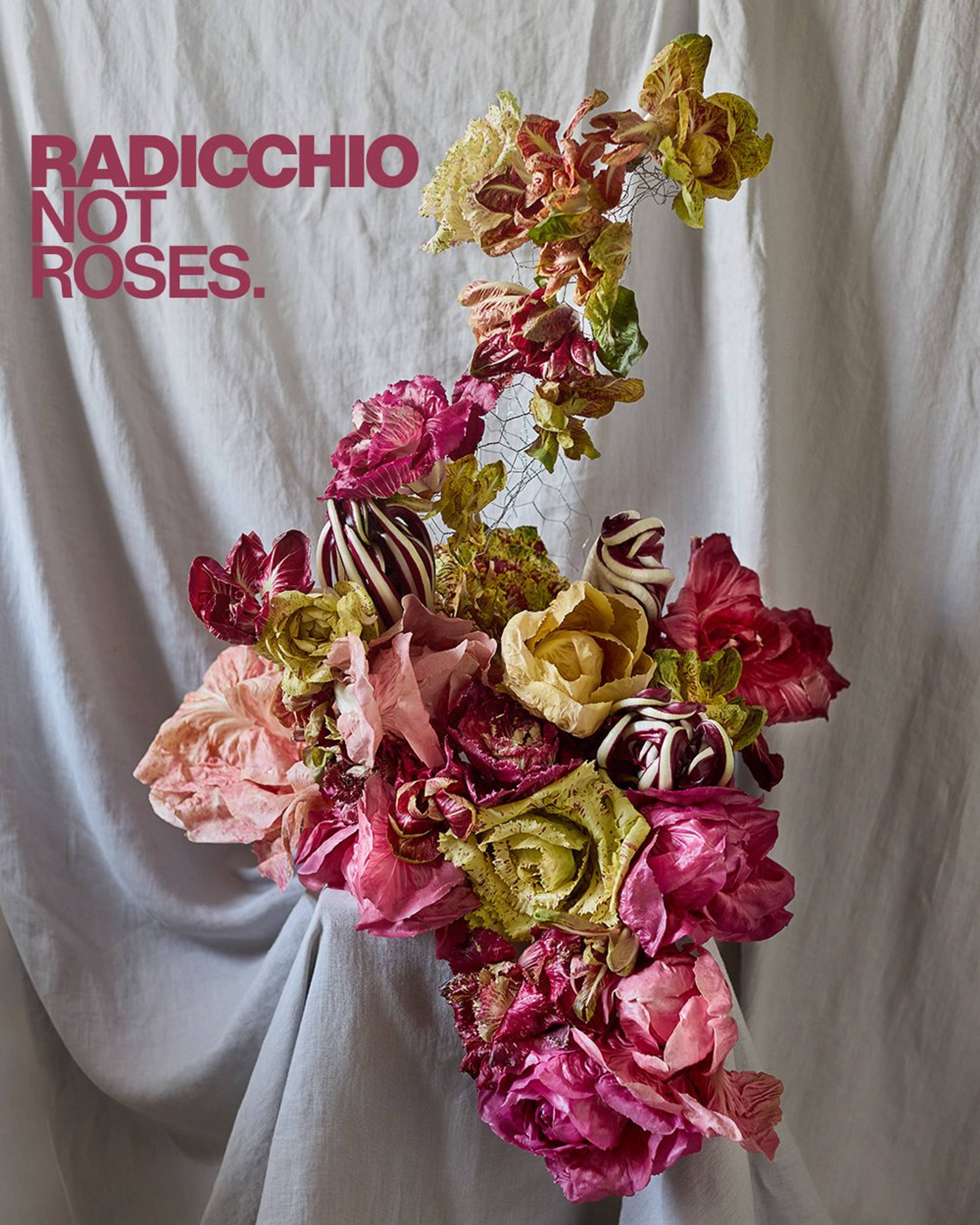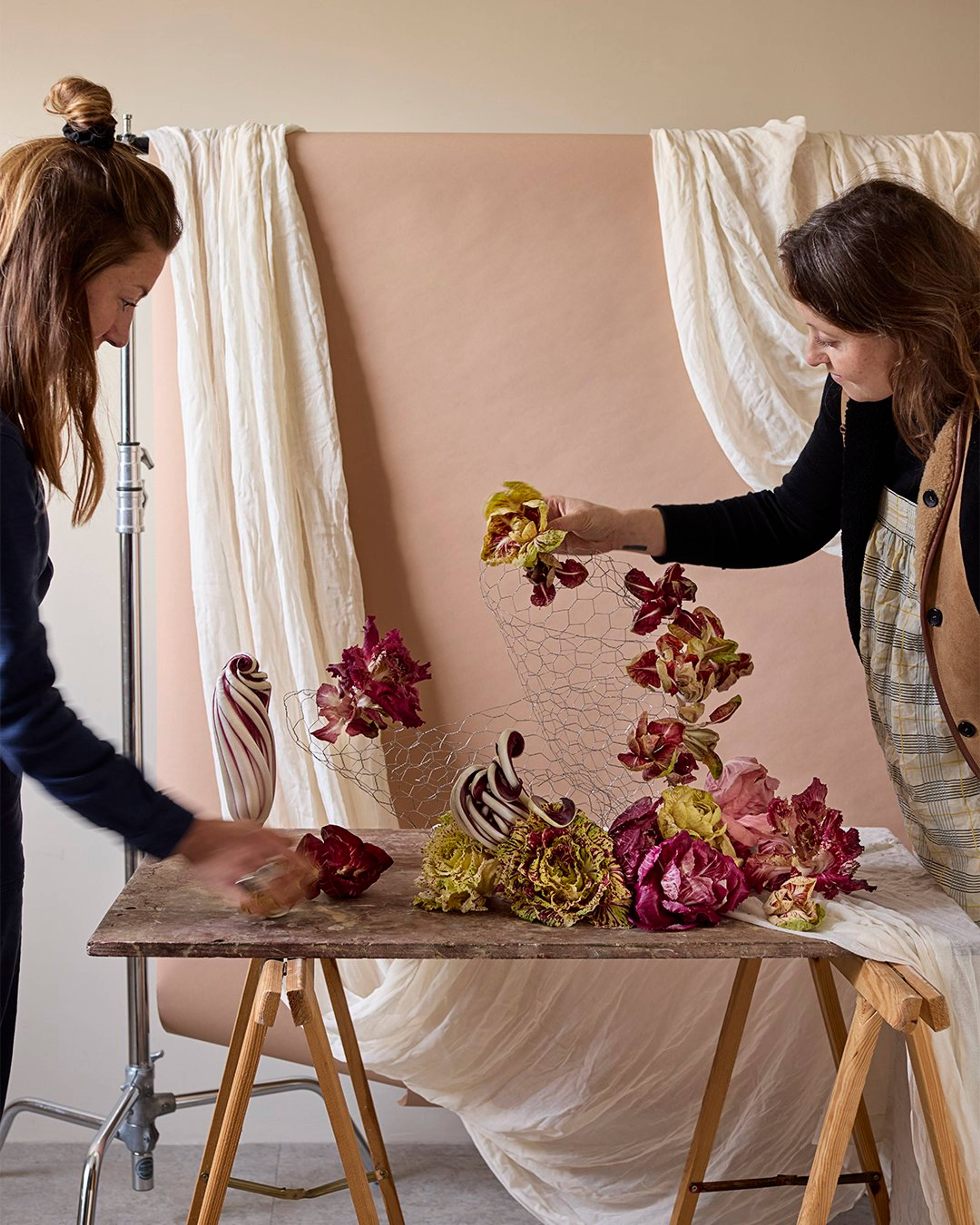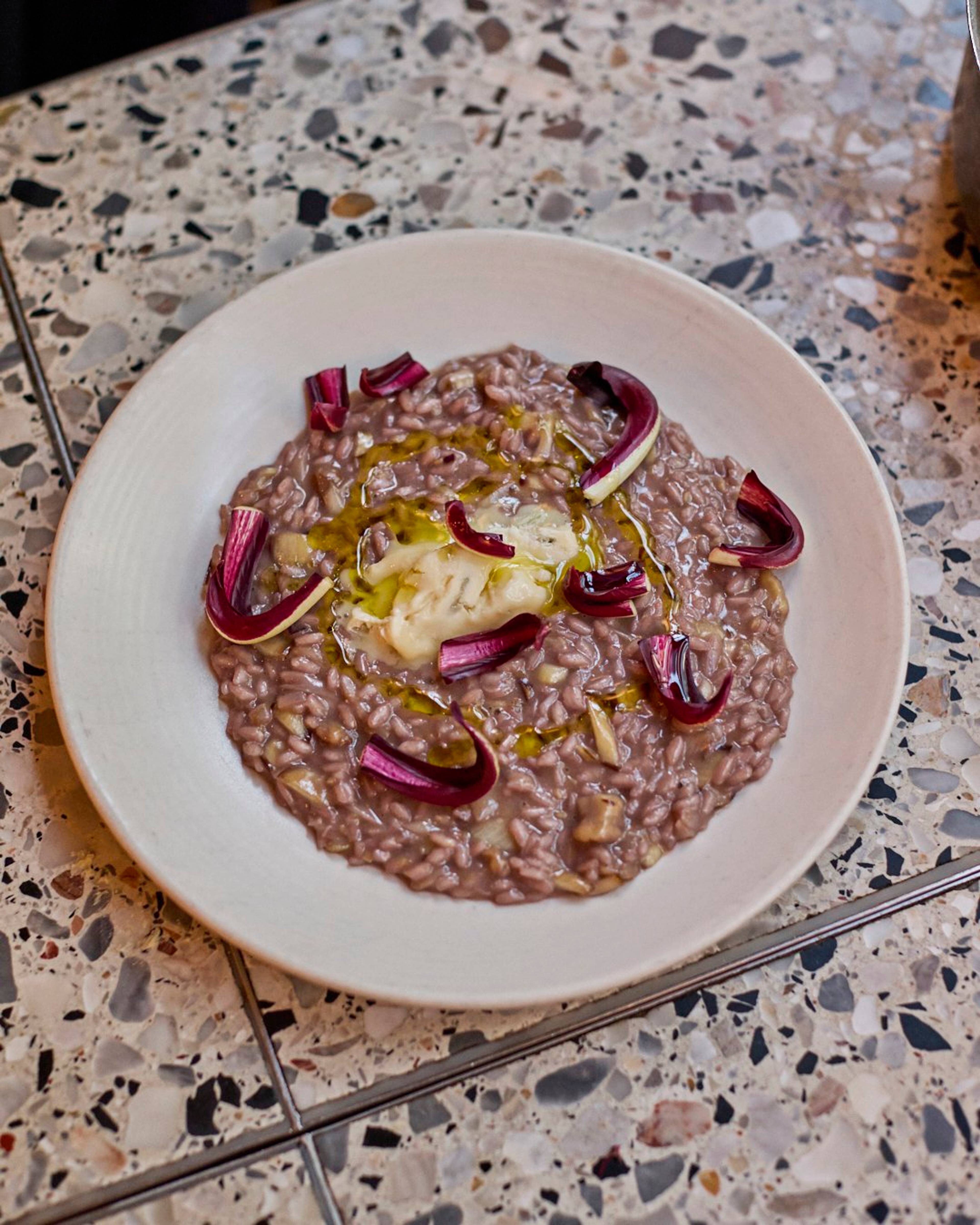RADICCHIO NOT ROSES 2023

Seasonal Radicchio from Veneto, Italy. Arranged by SSAW Collective
This Valentine’s Day, what impact do you want to have?
Give roses to support a system that is taking its toll on both people and planet.
250 million roses are grown for Valentine’s Day. Roses are in bloom from mid-spring to autumn. However, more are sold for Valentine’s Day than at any other time of year.[1]
Give radicchio: a seasonal alternative from Veneto.
Today, traditionally forced radicchio plants are fast disappearing as yield-driven cultivation dominates. Plus, the unpredictability of a growing season down to climate change means the stakes are higher than ever. This Valentine’s, back seasonality, preserve growing artistry and bring incredible flavours back from the brink of extinction.
BACK SEASONALITY
IN FEBRUARY, ROSES ARE NOT IN SEASON IN THE UK
They are imported from overseas countries including Colombia, Ecuador, Kenya and the Netherlands.[2]
In East Africa and South America, the climate is most conducive to growth at this time of year. In theory, this means the artificial heating and lighting of greenhouses as well as the use of harmful fertilisers and pesticides can be kept to a minimum.[2] In reality, large-scale, monoculture rose plantations have a detrimental social and environmental impact.
SOCIAL
Cultivation in these regions is also linked to negative social effects.[3] Roses are predominantly picked by a huge workforce of women who face more exploitative working conditions than their male counterparts and are paid below the living wage.[4] Plus, they are exposed to the toxins in fertilisers, insecticides and preservatives used to extend the life of blooms.[2] Overtime is generally compulsory and is particularly common at certain times of the year, such as Valentine’s Day.[5]
ENVIRONMENTAL
Each stem requires 10 litres of water to reach full size, contributing to high water use and chemical runoff. Depleting resources, some claim that drought-stricken Lake Naivasha in Kenya has seen half of its water drawn off for use in nearby greenhouses.[6]
Finally, stems are sprayed with chemicals, refrigerated and wrapped in plastic to withstand up to 6,000 miles in aeroplane holds.[7] Transported at speed, emissions are intensified, with an imported mixed bouquet producing ten times more carbon emissions than British-grown alternatives.
ALTERNATIVELY
Meanwhile, in colder countries like the Netherlands, the heating and lighting of greenhouses through winter results in three times the carbon footprint of Ecuadorian roses.[8]
To boycott imported blooms could cause major socio-economic collapse in those countries affected, but that does not mean we have to accept the current status quo. The key is conversation.
“You don’t need to ban roses. The system just needs to change.”
Liv, SSAW Collective

Arranging radicchio, SSAW Collective 2023
Last year, two remarkably similar campaigns were launched in the weeks leading up to Valentine’s Day. We urged shoppers to ‘Buy Radicchio, Not Roses’. SSAW Collective — the chefs, florists & growers committed to an ethical way of working with seasonal produce — asked, “Why buy roses in February”?
PRESERVE GROWING ARTISTRY
TRADITIONALLY-GROWN VENETIAN RADICCHIO IS ON THE BRINK OF EXTINCTION
VENETIAN RADICCHIO
Veneto, in Italy’s northeast, has maintained a long tradition of radicchio growing. For centuries wild chicory has been eaten here, thriving in the heavy, mineral-rich soils and fluctuating temperatures that drop below freezing for weeks at a time. Towns like Chioggia, Treviso, Castelfranco, Verona, Lusia and Gorizia all give their names to fiercely local varieties.
TRADITIONAL FORCING
However, these plants were elevated into a delicacy through careful selection, the passing on of traditional wisdom, and the development of an innovative cultivation process: forcing. After an initial period of outdoor growth, growers would re-plant their chicories in the dark, their roots often immersed in soil, spring water or sand. Triggered into new growth without photosynthesis, nutrient-dense, bittersweet and firm heads would form. By 1900 there were whole exhibitions celebrating these qualities.
Today, however, a different story dominates. Most growers opt for modern varieties designed to self-blanch in the field. The result: higher yields but depleted flavour in dull or overly bitter heads.
OUR GROWERS
A decade ago we came across Antonello’s chicories at the Lusia market in Veneto. From their striking colours to their densely packed heads, we recognised quality that only comes as a result of genuine artistry. Since then, we have built relationships with a number of small-scale, traditional growers going against the odds— Luca, Damiano, Torre and Simone.
A GREATER THREAT
This year, it’s more than yield which threatens production: it’s climate change. With winters getting warmer, the hard, cold frosts so vital to the process are happening later and less frequently. As a result, Antonello has not been able to grow one of his usual varieties — Castelfranco — for the first time.
Antonello
Working with Antonello for almost a decade, Natoora is the only source of his outstanding radicchio varieties outside of Veneto, Italy. From seed saving to sand-forcing, Antonello shares the cultivation methods that take his Pink Radicchio, Castelfranco and Rosello di Lusia to insane heights: Crisp, complex chicories prized by London and New York’s most flavour-focused chefs.
CHOOSE FLAVOUR, NOT WASTE
RADICCHIO IS EATEN, NOT WASTED AT END OF LIFE
Deep purple with tight, curled leaves or rosette-shaped with red speckles, bright red with crisp white veins or all hues of pink; we challenge you to find flowers more striking and vibrant than these radicchio heads.
In the UK, around 34,700 tonnes of cut flowers are used and wasted every year. At end of life, these are either sent to landfill, or home composted — a risk to soil health if those flowers have been grown and preserved with harmful chemicals.
At the end of their life as centrepieces, radicchio plants are eaten, not wasted. Their bittersweet complexity makes them ideal for cold-weather salads. Try with lemon, anchovy and garlic dressing or preserved lime and rose vinegar. Mix with fennel and blood orange or try it wrapped around hot smoked trout and kabocha squash onigiri (as an alternative to seaweed).
References
1. Valentine’s Day Floral Statistics
2. BBC, The 4,000 Mile Flower Delivery
3. The International Journal of Life Cycle Assessment, A comparison of cut roses from Ecuador and the Netherlands
4. Gender, Rights & Participation in the Kenya Cut Flower Industry
5. Socio-economic and Environmental Impact of Floriculture Industry in Ethiopia
6. Circle of Blue, Blooming Controversy: What Is Killing the Wildlife in Kenya’s Lake Naivasha?
7. Flowers From the Farm, The Carbon Footprint of Flowers
8. TED, The Environmental Impact of Cut Flowers? Not So Rosy
9. The Financial Times, How Green is Your Bouquet? The New Eco-Friendly Mindset in Floral Design
10. Live Frankly, Seasonal Flowers UK: Sustainable Flower Delivery
11. The Guardian, Roses are Dead … How to Choose a More Ethical and Original Bouquet this Valentine’s Day
12. Primrose Creations, Flower Waste Management: Can the Floral Industry Make a Change?
13. Centre for Environmental Policy Environmental Quality Research Group, Cut Flower Waste Management
Stories
Voir toutWe exist to fix the food system.
People are more cut off from the origins of their food than ever. This makes flavour, nutrition and farming practices that protect the planet, almost impossible to find.
By working directly with growers, we create a more sustainable way forward for farming. By giving everyone the tools to understand the power of our food choices, we empower everybody to become drivers of change.
Now is the time for action. Join the food system revolution.

Go beyond four seasons
Each fruit and vegetable has its own season, with subtle shifts which happen every day. Follow their microseasons to unlock flavour at every stage.
WHAT’S IN SEASON?

Know where your food comes from
We know the name of the people behind everything we source. Recognise their growing artistry to find out exactly where your food comes from (and why that matters).
MEET THE GROWERS

Make your diet diverse
Our growers work with varieties chosen for quality and nutrition, not yield. By selecting their crops you keep heritage seeds in play, add to ecosystem biodiversity and preserve unique flavours.
PEAK SEASON BOX
United Kingdom
© 2026 Natoora Ltd.
